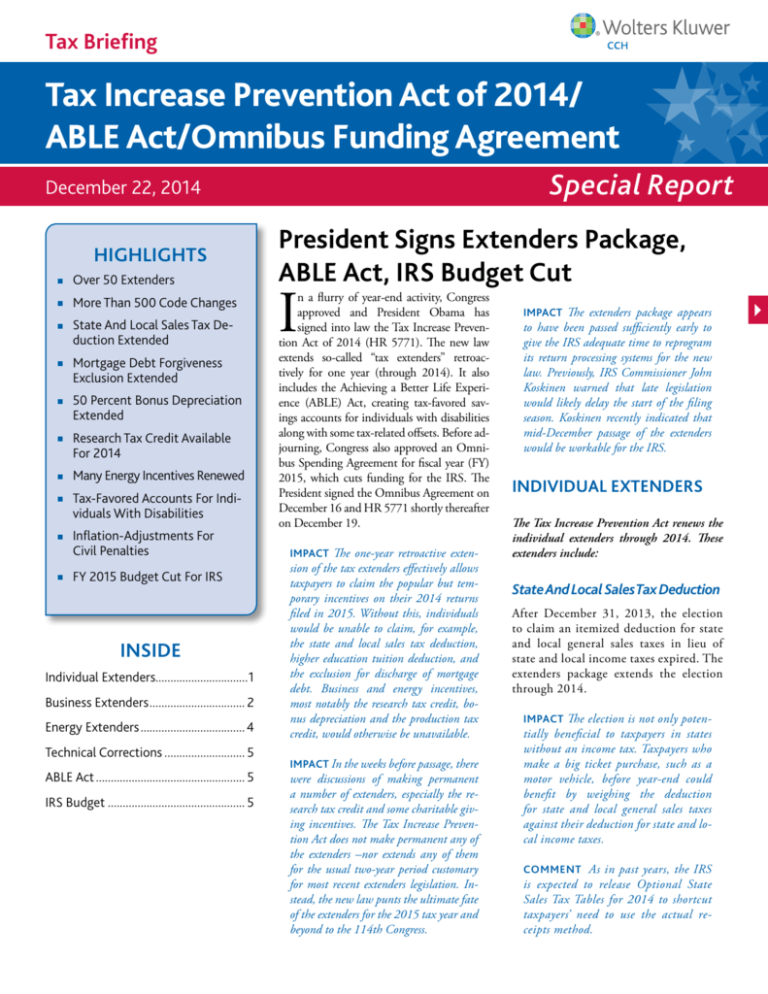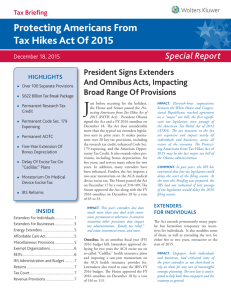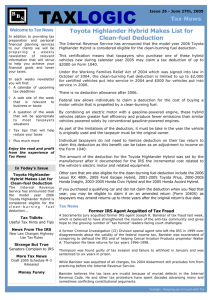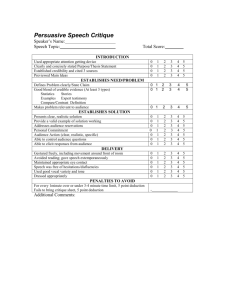
Tax Briefing
Tax Increase Prevention Act of 2014/
ABLE Act/Omnibus Funding Agreement
Special Report
December 22, 2014
HIGHLIGHTS
Over 50 Extenders
More Than 500 Code Changes
State And Local Sales Tax Deduction Extended
Mortgage Debt Forgiveness
Exclusion Extended
50 Percent Bonus Depreciation
Extended
Research Tax Credit Available
For 2014
Many Energy Incentives Renewed
Tax-Favored Accounts For Individuals With Disabilities
Inflation-Adjustments For
Civil Penalties
FY 2015 Budget Cut For IRS
INSIDE
Individual Extenders...............................1
Business Extenders................................. 2
Energy Extenders.................................... 4
Technical Corrections............................ 5
ABLE Act................................................... 5
IRS Budget............................................... 5
President Signs Extenders Package,
ABLE Act, IRS Budget Cut
I
n a flurry of year-end activity, Congress
approved and President Obama has
signed into law the Tax Increase Prevention Act of 2014 (HR 5771). The new law
extends so-called “tax extenders” retroactively for one year (through 2014). It also
includes the Achieving a Better Life Experience (ABLE) Act, creating tax-favored savings accounts for individuals with disabilities
along with some tax-related offsets. Before adjourning, Congress also approved an Omnibus Spending Agreement for fiscal year (FY)
2015, which cuts funding for the IRS. The
President signed the Omnibus Agreement on
December 16 and HR 5771 shortly thereafter
on December 19.
IMPACT The one-year retroactive exten-
sion of the tax extenders effectively allows
taxpayers to claim the popular but temporary incentives on their 2014 returns
filed in 2015. Without this, individuals
would be unable to claim, for example,
the state and local sales tax deduction,
higher education tuition deduction, and
the exclusion for discharge of mortgage
debt. Business and energy incentives,
most notably the research tax credit, bonus depreciation and the production tax
credit, would otherwise be unavailable.
IMPACT In the weeks before passage, there
were discussions of making permanent
a number of extenders, especially the research tax credit and some charitable giving incentives. The Tax Increase Prevention Act does not make permanent any of
the extenders –nor extends any of them
for the usual two-year period customary
for most recent extenders legislation. Instead, the new law punts the ultimate fate
of the extenders for the 2015 tax year and
beyond to the 114th Congress.
IMPACT The extenders package appears
to have been passed sufficiently early to
give the IRS adequate time to reprogram
its return processing systems for the new
law. Previously, IRS Commissioner John
Koskinen warned that late legislation
would likely delay the start of the filing
season. Koskinen recently indicated that
mid-December passage of the extenders
would be workable for the IRS.
INDIVIDUAL EXTENDERS
The Tax Increase Prevention Act renews the
individual extenders through 2014. These
extenders include:
State And Local Sales Tax Deduction
After December 31, 2013, the election
to claim an itemized deduction for state
and local general sales taxes in lieu of
state and local income taxes expired. The
extenders package extends the election
through 2014.
IMPACT The election is not only poten-
tially beneficial to taxpayers in states
without an income tax. Taxpayers who
make a big ticket purchase, such as a
motor vehicle, before year-end could
benefit by weighing the deduction
for state and local general sales taxes
against their deduction for state and local income taxes.
COMMENT As in past years, the IRS
is expected to release Optional State
Sales Tax Tables for 2014 to shortcut
taxpayers’ need to use the actual receipts method.
2014 Legislation Update
2
Higher Education Deduction
The higher education deduction allows taxpayers to deduct – above-the-line – qualified tuition and fees for post-secondary education. The extenders package extends the
deduction through 2014.
IMPACT The maximum deduction is
$4,000 for taxpayers with AGI not exceeding $65,000 ($130,000 for a joint return),
$2,000 for taxpayers with AGI $65,000-$80,000 ($130,000--$160,000 for joint
filers) and $0 for other taxpayers. Under
regulations, expenses paid by year-end for
an academic term starting on or before
March 31 of the following year qualify for
the deduction in the year paid.
Teachers’ Classroom Expense
Deduction
The teachers’ classroom expense deduction
allows primary and secondary education professionals (grades K-12, including school administrators and assistants) to deduct – abovethe-line – qualified expenses up to $250 paid
out-of-pocket during the year. Qualified
expenses must be reduced by any reimbursements from the taxpayer’s employer. The
extenders package extends the teachers’ classroom expense deduction through 2014.
IMPACT. Substantiation for qualified ex-
penses remains a requirement. Expenses
beyond the $250 limit may be deducted as
an itemized deduction only, subject to the
overall 2 percent adjusted gross income floor
on miscellaneous itemized deductions.
Mortgage Debt Exclusion
Unless excluded, cancellation of indebtedness income is included in income. The Tax
Increase Prevention Act of 2014 excludes
from income cancellation of mortgage debt
on a principal residence of up to $2 million
($1 million for a married taxpayer filing a
separate return) through 2014.
IMPACT Without an extension, debt
that is forgiven in 2014 through a
Tax Briefing
foreclosure, short sale or loan modification could be treated as taxable income. The existing insolvency exclusion,
as well as an exclusion when mortgage
debt is considered nonrecourse, continues to remain available.
Mortgage Insurance
Premium Deduction
This provision in the extenders package
treats mortgage insurance premiums as deductible interest that is qualified residence
interest subject to AGI phaseout. The extenders package extends this special treatment through 2014.
“The Tax Increase
Prevention Act does not
make permanent any of
the extenders and punts
the ultimate fate of the
extenders to the 114th
Congress…”
Charitable Distributions From IRAs
Individuals age 70 1/2 and older will continue to be allowed to make tax-free distributions from individual retirement accounts (IRAs) to a qualified charitable
organization. The treatment is capped at
a maximum of $100,000 per taxpayer
each year. This incentive is now extended
through 2014.
IMPACT If a taxpayer is married and
files a joint income tax return, his or
her spouse can also have a qualified deduction and exclude up to $100,000.
Amounts in excess of $100,000 must
be included in income but may be
taken as an itemized charitable deduction, subject to the usual AGI annual
caps for contributions.
Transit Benefits Parity
The Tax Increase Prevention Act of 2014 extends “transit benefits parity” through 2014.
This extension provides that the income exclusion for employer-provided mass-transit
and parking benefits will remain on equal
footing for 2014: at $250/month.
IMPACT Parity will become an immedi-
ate issue again in 2015 when, under the
law, mass-transit pre-tax benefits will be
capped at $130 and parking at $250 (as
adjusted for inflation).
COMMENT After the most recent ex-
tension of transit benefits parity (for
2012 and 2013), the IRS provided
special rules for application of the retroactive increase in excludable transit
benefits. In certain cases, employers
could make adjustments on their Form
941, Employer’s Quarterly Federal Tax
Return. The IRS is expected to provide
similar relief for 2014.
Contribution Of Real Property For
Conservation Purposes
A special rule allows contributions of capital
gain real property for conservation purposes, with the contribution to be taken against
50 percent of the contribution base. The
extenders package extends this special rule
through 2014.
BUSINESS EXTENDERS
The Tax Increase Prevention Act extends
many business tax incentives for one year
retroactively to January 1, 2014. These extenders include:
Bonus Depreciation
Bonus depreciation allows taxpayers to
claim an additional first-year depreciation
deduction. The Tax Increase Prevention
Act of 2014 extends 50-percent bonus depreciation through 2014 (through 2015 for
©2014 CCH Incorporated. All Rights Reserved.
December 22, 2014
3
certain property with a longer production
period and certain aircraft).
IMPACT Qualified property must be
depreciable under the Modified Accelerated Cost Recovery System (MACRS)
and have a recovery period of 20 years or
less. Property must be new and placed in
service before January 1, 2015 (January
1, 2016 for certain longer production period property and certain aircraft).
IMPACT The extension of 50-percent bonus
depreciation effectively results in an $8,000
increase in first year depreciation caps for
vehicles purchased in 2014. As a result of
this extender, the luxury auto depreciation
limit under Code Sec. 280F for passenger
automobiles placed in service in 2014 is
now $11,160 (rather than only an inflation-adjusted $3,160); and for trucks and
vans first placed in service during the 2014
calendar year, it is now $11,460 (rather
than only $3,460) for 2014.
IMPACT The Tax Increase Prevention Act of
Qualified leasehold improvements, qualified retail improvements and qualified restaurant property may be treated as Code
Sec. 179 property, but with a lower dollar
cap. The extenders package extends this
treatment through 2014.
IMPACT Under the extenders pack-
age, taxpayers may elect to treat up to
$250,000 of qualified leasehold/retail
improvement, restaurant property as
Code Sec. 179 property.
Research Tax Credit
preciation in the tax year that a qualifying asset in placed in service. This may
not necessarily be the same tax year that
the asset is acquired. Only new property is
eligible for bonus depreciation.
IMPACT The extenders package also ex-
IMPACT The research credit generally
tends the election to accelerate the use of
AMT credits in lieu of bonus depreciation.
Code Sec. 179 Expensing
Enhanced Code Sec. 179 allows taxpayers to
immediately deduct, rather than gradually depreciate, the cost of qualified assets, subject to
certain limitations. The extenders package sets
the Code Sec. 179 dollar limit at $500,000 for
2014 with a $2 million overall investment limit.
IMPACT Absent Congressional action, the
dollar limit for Code Sec. 179 expensing
was $25,000 for 2014 with an investment limit of $200,000. Code Sec. 179
expensing has been at the $500,000/$2
million level since 2010. It returns to the
$25,000/$200,000 level in 2015 without further action by Congress.
COMMENT The research tax credit was
identified as one key incentive to be made
permanent in the failed House-Senate negotiations in November. As in past negotiations, the cost of a permanent credit emerged
as one of the greatest stumbling blocks.
Qualified Leasehold/Retail
Improvements, Restaurant Property
The research tax credit may be claimed for
increases in business-related qualified research expenditures and for increases in
payments to universities and other qualified
organizations for basic research. The Tax Increase Prevention Act of 2014 extends the
research tax credit through 2014.
COMMENT Taxpayers claim bonus de-
enhancing the credit, the extenders package contains no enhancements, leaving
them to the 114th Congress.
2014 also extends through 2014 the special
rule allowing off-the-shelf computer software
to be treated as Code Sec. 179 property.
allows taxpayers a 20-percent credit for
qualified research expenses or a 14 percent
alternative simplified credit. Although
there had been last-minute discussions of
Work Opportunity Tax Credit
Employers that hire military veterans and other qualified individuals may be eligible for the
Work Opportunity Tax Credit (WOTC). The
credit amount is generally equal to 40 percent
of up to $6,000 (higher for some veterans) in
qualified first-year wages. The Tax Increase
Prevention Act of 2014 extends the WOTC
through 2014, for employees who begin work
for the employer before January 1, 2015.
100-Percent Exclusion For Gain
On Qualified Small Business Stock
The 100-percent exclusion allowed for gain
on the sale or exchange of qualified small
business stock held for more than five years
by non-corporate taxpayers has been extended for one more year, applicable to
stock acquired before January 1, 2015.
IMPACT Stock acquired after 2014 will be
entitled to only a regular 50 percent exclusion if not extended again by Congress.
COST OF SELECTED EXTENDERS*
Research Tax Credit
$7.629 billion
Mortgage Debt Forgiveness
$3.143 billion
State And Local Sales Tax Deduction
$3.142 billion
15-Year Recovery Leasehold/Retail Improvement, Restaurant Property
$2.382 billion
Work Opportunity Tax Credit
$1.375 billion
Incentives For Biodiesel And Renewable Diesel
$1.297 billion
Code Sec. 25C Residential Energy Credit
$832 million
Tuition And Fees Deduction
$300 million
Source: Joint Committee on Taxation, December 3, 2014
*cost over 10 years ($81.369 billion cost in 2015); $41.599 billion over 10 years)
Tax Briefing
2014 Legislation Update
4
Reduced Recognition Period For
S Corporation Built-In Gains Tax
The Tax Increase Prevention Act of 2014
extends to sales of assets occurring during
2014, the five-year recognition period for
built-in gain following conversion from a C
to an S corporation. The period, normally
10 years, generally begins with the first day
of the first tax year for which the corporation is an S corporation.
IMPACT A corporate-level tax, at the high-
est marginal rate applicable to corporations
(currently, 35 percent), is imposed on an S
corporation’s net recognized built-in gain
(for example, gain that arose prior to the
conversion of the C corporation to an S corporation and is recognized by the S corporation during the recognition period).
More Business Extenders
A lengthy list of other business extenders expired after 2013. The Tax Increase Prevention Act of 2014 includes one-year, retroactive extensions for 2014 dealing with the:
New Markets Tax Credit;
Employer wage credit for activated military reservists;
Subpart F exceptions for active financing income;
Look through rule for related controlled
foreign corporation payments;
Railroad track maintenance credit;
Classification of certain race horses as
three-year property;
Seven-year recovery period for motorsports entertainment complexes;
Enhanced deduction for charitable contributions of food inventory;
Tax incentives for empowerment zones;
Indian employment credit;
Accelerated depreciation for business
property on Indian reservations;
Special expensing rules for qualified film
and television productions;
Mine rescue team training credit;
Election to expense advanced mine safety equipment;
Qualified zone academy bonds;
Low-income tax credits for non-federally subsidized new buildings;
Low-income housing tax credit treatment of military housing allowances;
Treatment of dividends of regulated investment companies (RICs);
Treatment of RICs as qualified investment entities;
S corporations making charitable donations of property;
Puerto Rico domestic production activities deduction;
Cover over of rum excise taxes; and
Economic development credit for
American Samoa.
COMMENT The extenders package also
increases the threshold for the Joint Committee on Taxation’s mandatory review of
C corporation refund claims from $2 million to $5 million.
Multiemployer Pension Plans
“Division D” of the Tax Increase Prevention
Act includes special provisions for multiemployer pension plans. Generally, multiemployer pension plans will continue to be able
to take an additional five years to amortize
funding shortfalls. This extension would otherwise expire at the end of 2014. The Act also
extends special rules for three categories of
severely underfunded multiemployer plans.
Both provisions are extended through 2015.
SOME EXTENDERS NOT EXTENDED
The Tax Increase Prevention Act does not extend:
• Plug-in Electric Vehicle Credit
• Energy-Efficient Appliance Credit
• Placed-In-Service Date For Partial Expensing Of Certain Refinery Property
• New York Liberty Zone Tax-Exempt Bond Financing
• Health coverage credit for displaced workers
Tax Briefing
ENERGY EXTENDERS
Incentives for energy conservation and the
production of alternative fuels expired after 2013. The Tax Increase Prevention Act
of 2014 extends the following incentives
through 2014:
Code Sec. 25C Credit
The Code Sec. 25C nonbusiness energy
property credit rewards taxpayers who make
qualified energy efficiency improvements to
residential property. The Tax Increase Prevention Act of 2014 extends the Code Sec.
25C credit through 2014.
IMPACT Examples of qualified Code Sec.
25C property are improvements such as
adding insulation, energy efficient exterior windows and energy efficient heating
and air conditioning systems.
Production Tax Credit
The production tax credit (PTC) provides
a per-kilowatt-hour tax credit for electricity
generated by qualified energy resources and
sold by the taxpayer to an unrelated person.
The Tax Increase Prevention Act of 2014 extends the PTC through 2014.
Biodiesel And Renewable Diesel
The Tax Increase Prevention Act of 2014 extends through 2014 the production credit
for biodiesel and the production credit for
diesel fuel from biomass. The small agribiodiesel producer credit is also extended.
More Energy Extenders
Other energy incentives extended by the Tax
Increase Prevention Act of 2014 include:
Second generation biofuel producer credit;
Production credit for Indian coal facilities;
Credit for energy-efficient new homes;
Second generation biofuel plant property;
Deduction for energy-efficient commercial buildings;
Special rules for sales of electric transmission property;
©2014 CCH Incorporated. All Rights Reserved.
December 22, 2014
5
Excise tax credits for alternative fuels; and
Credit for alternative fuel vehicle refueling property.
TECHNICAL CORRECTIONS
Technical corrections are corrections to the
text of laws necessary to ensure that the laws
are implemented as intended. The Tax Increase
Prevention Act of 2014 makes technical corrections to, among other laws, the American
Taxpayer Relief Act of 2012 (ATRA), the Tax
Relief, Unemployment Insurance Reauthorization and Job Creation Act of 2010, the American Recovery and Reinvestment Act of 2009,
and the Economic Stimulus Act of 2008.
ABLE ACT
The Achieving a Better Life Experience
(ABLE) Act (“Division B” of the Tax Increase
Prevention Act of 2014 (HR 5771)) creates
tax-favored savings accounts for individuals
with disabilities for tax years beginning after
December 31, 2014. The ABLE Act authorizes
states to create an ABLE Program (similar to
Code Sec. 529 college savings programs).
IMPACT Qualified distributions include
amounts used to cover medical expenses
as well as costs of education, transportation and housing. Distributions used for
nonqualified expenses would be subject to
income tax on the portion of the distributions attributable to earnings from the
account, plus a 10 percent penalty.
IMPACT Individuals with disabilities
would be limited to one ABLE account;
and total annual contributions by all
individuals to any one ABLE account
could be made up to the gift tax exclusion
amount. For 2015, the gift tax exclusion
amount is $14,000.
529 Plans
The ABLE Act also authorizes investment direction for Code Sec. 529 plans by an account
contributor or designated beneficiary up to
two times each year. The change is effective for
tax years beginning after December 31, 2014.
collect unpaid taxes. The change is effective
for levies issued six months after enactment.
OFFSETS
Inland Waterways Excise Tax
The ABLE Act contains a number of taxrelated offsets, as well as offsets related to
Medicare and workers’ compensation (The
extenders portion of the new law by agreement is not offset by any tax increases.) The
ABLE Act offset provisions include:
Professional Employer Organizations
The ABLE Act authorizes the IRS to certify qualifying professional employer organizations (PEOs), which would allow the
PEO to become solely responsible for the
customer’s employment taxes. The ABLE
Act requires the IRS to establish a PEO
certification program by July 1, 2015 with
a $1,000 annual user fee to participate.
Dividends From CFCs
The ABLE Act excludes dividends received
from a controlled foreign corporation from
the definition of personal holding company
income. This treatment is effective for tax
years ending on or after the date of enactment.
Penalties
Effective for returns filed after December 31,
2014, the ABLE Act indexes for inflation certain civil tax penalties. They include penalties
under Code Sec. 6651 for failure to file a tax
return or to pay tax; Code Sec. 6652(c) failure
to file certain information returns, registration statements, and certain other statements;
Code Sec. 6695 failure of a paid preparer to
meet certain obligations; Code Sec. 6698 failure of a partnership to file a return; Code Sec.
6699 failure of S corporation to file a return;
and Code Sec. 6721(f)(1) failure to file correct
information returns and payee statements.
Levy
The ABLE Act increases the IRS levy authority on payments to Medicare providers to
The inland waterways fuel excise tax funds the
Inland Waterways Trust Fund. The ABLE Act
increases the excise tax to 29 cents per gallon.
FY 2015 IRS BUDGET
Just before adjourning, Congress approved a
FY 2015 Omnibus Funding Agreement for
the federal government. The Omnibus agreement, within its $1.1 trillion package, funds
the IRS at $10.945 billion for FY 2015, which
is $346 million less than FY 2014 funding.
IMPACT IRS Commissioner John Koskinen
has cautioned that reduced funding will be
reflected in further cuts to customer service
and enforcement. The Omnibus agreement
specifically instructs the IRS to improve its
1-800 helpline and enhance response times.
COMMENT The Omnibus agreement di-
rects the IRS to submit quarterly reports to
Congress concerning advance payments of
the Code Sec. 36B premium assistance tax
credit, accelerate help for victims of identity
theft, intensify its scrutiny of payroll service
providers, and address fraud and filing errors in refundable credit programs. Additionally, the Omnibus agreement directs the
IRS to report to Congress on its policy for
the payment of bonuses to employees, update
lawmakers about the Free File Program
and the Taxpayer Assistance Blueprint, and
identify assistance for rural taxpayers.
COMMENT The Omnibus agreement ex-
tends a limited prohibition on certain corporate inverters that move their corporate
“residences” offshore from contracting with
the federal government, as well as extending
the internet sales tax ban for one additional
year. The Omnibus agreement also amends
the rules for multiemployer pension plans to
allow some struggling plans to reduce benefits to current retirees and exempts expatriate
health plans from the Affordable Care Act.
Tax Briefing
Resources you can count on for
the latest legislative coverage
Tax Increase Prevention and ABLE Acts of 2014 and
Other Recent Tax Acts: Law, Explanation & Analysis
On December 16, 2014, Congress passed the Tax Increase Prevention Act of 2014,
extending nearly all of the so-called Tax Extenders for a one-year period applying
retroactively to the 2014 tax year, and the ABLE Act, which provides for the
establishment of tax favored accounts to allow for care and support for individuals
with disabilities. Understand how these Acts affect your clients.
ll
Technical corrections for over ten years of tax legislation under the Tax Increase Prevention Act
ll
New rules relating to IRS levies and penalties under the ABLE Act
ll
Coverage of the Consolidated and Continuing Appropriations Act, 2015
Just $75.00
BUY NOW
CCH ® Federal Tax Perspectives: 2014 Update to Final Repair/Capitalization/MACRS
Regulations eBook
Receive a comprehensive update on those requirements and opportunities that have evolved from the final
regulations on repairs, capitalization and the modified cost recovery system (MACRS).
ll
Refined criteria for defining capitalized betterment and restorations to tangible property
ll
Covers deduction rules for materials and supplies and unit of property definitions
ll
uidance on the new MACRS elections and the accounting method changes
G
under the repair and MACRS regulations
CCH® Federal Tax Perspectives:
2015 Subscription......................................$49.95
BUY NOW
Just $19.95
CCH® Federal Tax Perspectives:
2014 Year-End Planning eBook.............. $19.95
BUY NOW
BUY NOW
This convenient subscription package will automatically
provide you with all CCH Federal Tax Perspectives
publications that become available throughout the year.
Also Available:
CCH® State Tax Perspectives:
2014 California Tax Updates
and Insights eBook............. $19.95
Attend CCH Seminars
and Earn CPE!
BUY NOW
Authoritative seminars in the convenience of your office
on a variety of tax and accounting topics, including
the latest developments and tax legislation changes.
Visit CCHGroup.com/Seminars for a
calendar of upcoming CCH Seminars.
U.S. Master Tax Guide®, 2015
................................................ $97.25
BUY NOW
eBooks and eBook combinations can only be purchased online. eBooks cannot be
returned for credit or put on standing order. Visit CCHGroup.com/eBooks
to learn more about ordering eBooks online and to review our end-user agreement.
2014-0216-6
Visit CCHGroup.com/Legislation for
the latest updates as they happen.





